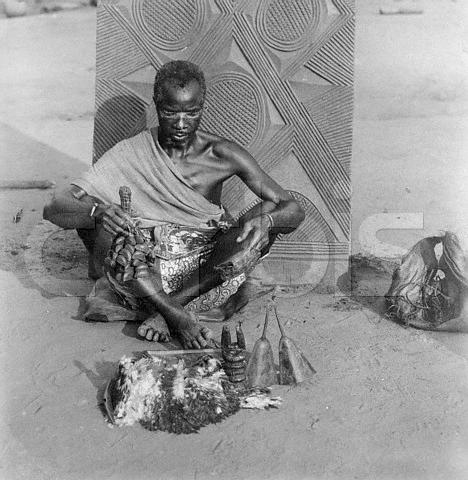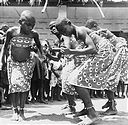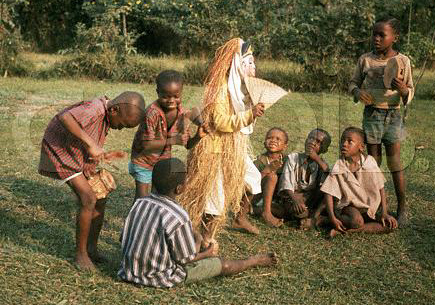

HOW
IS
IBEKU....ORGANIZED
------------------------------------

From time
immemorial the name Ogurube is held in reverence and
personified in the Traditional Ruler of the clan. Today, by the grace
of God, the mantle of this reverence is worn by His Royal Highness,
Eze Samuel Iheonye Onuoha, the Ogurube IV of Ibeku. He is the
keeper of the Customs and Tradition of the people and the Ofo
Holder
, the traditional mace.
One of the errors being made by various people includes terminating
our history at the slave trade period. The slave period is a very
resent event. There was a system of organization and communication in
existence between kinsmen, neighbor and other clans before the slave
trade. This communication allowed the trade to flourish with out
inter-clan wars. Do not forget that many clans resisted the trade but
they were met with higher firepower in gun battles.
THE ELDERS
We had direct rules
Do not forget that some of the earlier system still exists. This is by
which mostly the eldest person in the family,Ama or the village has the
final say and must be consulted. No visitors, no marriage, no war, no
newborn ceremony, no death burial, no festival happens without
consultations with the elders.
But when the white merchants who were in search of Ivory and other
goods came into town, they did not want to deal the elders with their
ways of doing things. The white traders decided to appoint
representatives that must relay their messages to the people. They
called these people CHIEFS. There were many noncooperation from the
people as to where the orders were coming from. The bypassed the EZES.
They were not welcomed with their new tactics.
They brought in law enforcers by setting up the court system that
worked against the existing EZE and Elders systems. These agents were
called Court Men short for Court Messenger but in Igbo vernacular is
called CORTIMA.
 White
with their assistants
cortima
White
with their assistants
cortima  Medicine man
1920
Medicine man
1920
This was an indirect rule system in which the white people did not go
to the elders anymore but these Chiefs relayed to the Elders. One of
the famous court systems the white people set up in umuahia was on a
hill at UMUOBIA OLOKORO. That place is still being called ISHICOURT.
This location is the present Old Umuahia- Olokoro -Amakama road
junction in Umuobia . They also built a railway station close to it
called the Old-Umuahia rail Station.
On many occasions, the resident Eze did not want to deal with these
white people. The Ezes did not want to travel to go and meet with these
new visitors. Hence the Ezes sent their trusted right hand men or
agents as representatives. Many of these errand men were made chiefs.
The above set up still cause problems in many villages and clans were
the descendants of these errand agents are tussling with the original
Eze linage for EZESHIP. Do not forget that this is the reason many
places still have their EZE events held up in the court system.




IBEKU LEVEL
Ibeku has one EZE called THE OGURUBE IBEKU. The OGURUBE title is a 20th
century event.
We are still putting together the names and other mechanisms before the
time of OGURUBE TITLE.
Ibeku is made up of seven [asaa] brothers called EGWU. Thus the name
:IBEKU EGWU ASAA.
The names of these groups are not in Alphabetical order
Amuzu Ukwu [2] Amuezeagwu [3] Mbom [4]Ugba [5]Nkata [6]Amaeke [7] Isiadu
[2] AFARA UKWU
click
Isiama [2] Okwulaga [3] Ohokobe na Umuokeyi
[3] AMAOFORO
Ajata-Okwuru [2] Iyienyi [3] Avo nkwu [4] Amuzu ora [5]Erote
[4] EMEDE
Nkpuru [2] Ata [2]Umuakanu [3] Umuagu [4] Umueze [5]Agbo [6] Umuodudu [7]Odide [9] Ubani
[5] ISIEKE
Umuajiji [2] Okwuta [3] Ihie [4] Ajata [5] Ukome [6] Okwoiyi
[6] NDUME
Umuafai [2] Umuezeala [3] Ohokobe [4] Umuohu [5] Ahieke [6] Ihie [6] Umuana [7]Lodu [8] Umuhute [9] Umuaroko [10] Umuohu-Azueke
Uzi [2] Eziama [3] Mgbaja [4] Uhabiri [5] Umuchima [6] Amanso
EGWU LEVEL
This is a very tight level of organization running on precision. The
size of each egwu varies. But every egwu is made up of several
UMUNNAS, villages and many AMAs.This means that there must always be a
level of understanding
between the Chief of that Egwu and various ummunnas. There must be a
reflection of broader interests than that of one lone ranger.
Difficulties always come up at this level because of perceptions.
FAMILY SET UP
The family set up in Ibeku is like every other in many
ways alike in Igbo land. This is the primary ibeku structure of
organization. The man [A] gets a wife, if dictated by conditions gets
two wives or more [B,C].

They will have children
[D,E,F,G,H,I ] where [D,I] are females that are from both wives [B,C]
all belonging to the man [A]who is now the head of his own
family. This is now his ONU
ULO, ONU MKPU
[household]. Mkpu here means his house, this generally is
specific in nature to a particular building. In the case of two or more
wives, each wife lives in her mkpu and the combinations of all the
mkpus belonging to Mr. A is collectively called his ONU ULO. It must be pointed
out that every wife is given a separate house for her and children. Mr.
A has and lives in a central building that is accessible by all his
household makeup. These Children are also grouped uniquely in a very
simple way. Children DEF from mother B are called NWANNE { from
the same mother} Children DEF from mother C are called NWANNE { from
the same mother}. All the Children DEFGHI are NWANNA { from the
same father}. These distinctions come up only during inheritance
activities and a not easily noticed and identified from the outside.
When DEFGHI get married and have children., The family of
Mr. A is now growing. He is now a grandfather. Note that the
female [D,I] will be married out. But we can track their progress from
this diagram. This is now his EZI NA
ULO, his household but with the extended ones.

The gradchildren they themselves will get married, adding to the
numbers. They all retain and go by the name of Mr. A. This large family
will now live in a larger area of the village called AMA.
AMA LEVEL
This next level is sectioned into what is called AMA. Here groups of
families from the same descendants cluster their homes together. In
many instances, they all have the same great grandfather.You can tell
and identify every body at this level by his or her last name. This AMA
system is also very tricky because some person might decide to move to
a new setting. He still has to be linked back to where he departed
from, his ORIGINAL AMA or AMA OCHIE
They will grow in family size and have many AMAs , this is then called UMUNNA
[Children of the same father] . This level gives the
recognision noted as the Social stautus of every IBEKU individual. The
children of every ibeku woman married outside that AMA is now called
NWANDIEM { child of our daughter}. This is very important in ceremonial
functions because they are recognized accordingly.The child is on
a visit to his/her UMUNE on any visit to the place of his mothers
origin.They are also given the first protection in any even. It is also
at this level that the recognisions for the first sons, age groups are
established. All the villages and clans are set in order of age
seniority in ceremonies disregarding the ages of those present at the
ceremony. Individual's age come to paly in general recognision. The
eldest person is always the spokes person, chairs every meeting as the
wisest human alive in the clan, and is the default ruler, nothing gets
done without his knowledge. In every inter Ama activity, the oldest
person is the grand patron.

UMUNNA LEVEL
At this lower level the organization becomes very personal. This is a
very interesting level. This is where we direct descendants meet
generations. SEE UMUIZU CLAN OF OKWULAGA
AFARAUKWU IBEKU . There is never an inter marriage involved from
this level down.

If one happens to move from his own to another
umunna, he will get his administrative orders from his original umunna.
His descendants must be tracked to avoid their inter
marriage with thier old relatives. Family relocation within umunna
level is less
problematic than relocating outside your umunna.
This is why making a family tree of any village is very easy to do from
any starting point in the clan system.